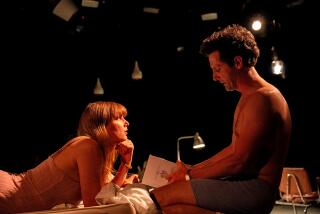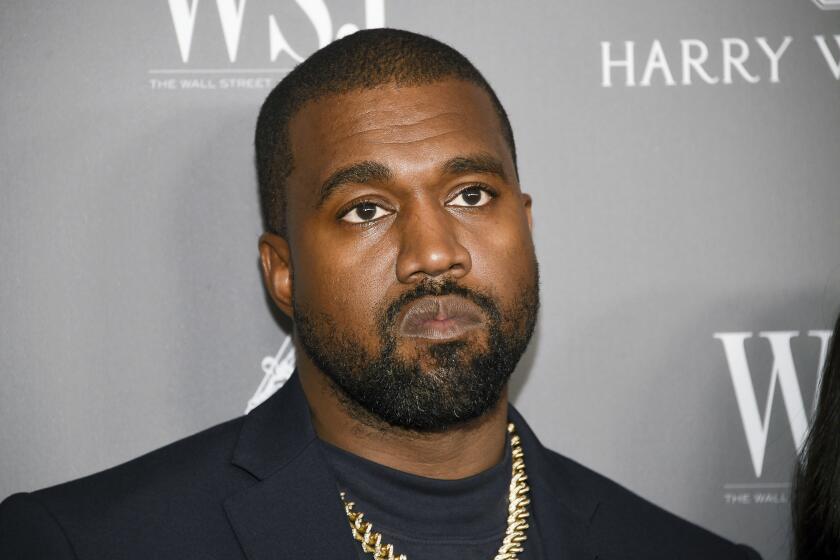THEATER REVIEW : Wrenching, Memorable Rise From Madness in ‘Barnes’
- Share via
In Wonderland, Alice protests the Cheshire Cat’s suggestion that she visit the Mad Hatter or the March Hare, saying, “I don’t want to go among mad people.” To which the Cat calmly replies, “Oh, you can’t help that. . . . We’re all mad here.”
To controversial Scottish-born psychiatrist and social critic R.D. Laing, madness was largely relative. An iconoclast who experimented with hallucinogens in his efforts to redefine schizophrenia, Laing persistently questioned the sanity of many of society’s institutions, particularly the family.
Who, then, is “mad” and who “sane”? For Laing, the Cheshire Cat of psychoanalytic theory, this was an all-consuming question. However, for many who must live with a schizophrenic, the answer is sadly self-evident.
David Edgar’s play “Mary Barnes,” first produced at the Odyssey in 1983 and currently being revived in honor of the theater’s 25th anniversary season, concerns Laing’s formation of a community of “mad psychiatrists and lunatics” in East London in the mid-1960s. More crash pad than clinic, the free-wheeling community, which prided itself on the absence of rules and hierarchy, implemented a radical approach to the treatment of mental illness. Because of (or in spite of) the therapy she received there, the real-life Mary Barnes, a periodic schizophrenic, pulled herself out of madness to live a normal life--in fact, to become a renowned artist and author.
Edgar’s play could be construed as promulgating the theory that schizophrenia can be effectively treated through behaviorist methods alone, sans antipsychotic drugs. Despite the bravery and audacity of Laing’s experiment, and in light of the recent advances in antipsychotic drug therapy, Barnes’ case should probably be perceived as the remarkable emission of an incurable disease, more a singular mercy than a proven therapeutic breakthrough.
Although Edgar’s play may be, in this respect, reductionist, it is a brilliant piece of pure theater, beautifully realized by the gut-wrenching, uncompromising staging of director Ron Sossi, who also directed the 1983 production.
Reprising her earlier performance in the title role, Laurie O’Brien takes us on a stunning descent into “the cruelest disease.” Ebullient Eric Drachman plays Joe, Mary’s idealistic therapist, whose own personal frustration mounts along with Mary’s manipulative neediness. Dave Higgins (who recently portrayed Dylan Thomas in the Skylight Theatre’s acclaimed production of “Dylan”) displays a sardonic avuncularity as Hugo, the Laing-like head of the experimental commune.
Eric Warren’s seedy set captures the counterculture funkiness of the period. Kathi O’Donohue’s splendid lighting provides an effective visual metaphor for Mary’s halting progression from darkness to light.
For those families and friends of schizophrenics, Edgar’s behaviorally slanted play may be cruelly misleading, but this production--and indeed Mary Barnes herself, who was present in the audience on opening night--remain compelling proof of the resiliency of the human spirit.
* “Mary Barnes,” Odyssey Theatre Ensemble, 2055 S. Sepulveda Blvd. Wednesdays-Saturdays, 8 p.m.; Sundays, 7 p.m.; April 23 and May 7 only, 2 p.m. Ends May 14. $17.50-$21.50. (310) 477-2055. Running time: 3 hours, 10 minutes.
More to Read
The biggest entertainment stories
Get our big stories about Hollywood, film, television, music, arts, culture and more right in your inbox as soon as they publish.
You may occasionally receive promotional content from the Los Angeles Times.










